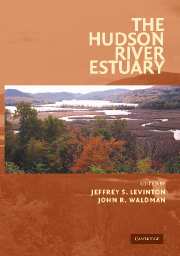Book contents
- Frontmatter
- Contents
- Preface
- List of Contributors
- The Hudson River Estuary
- 1 The Hudson River Estuary: Executive Summary
- GEOLOGICAL, PHYSICAL, AND CHEMICAL SETTING OF THE HUDSON
- PRIMARY PRODUCTION, MICROBIAL DYNAMICS, AND NUTRIENT DYNAMICS OF THE HUDSON
- HUDSON RIVER COMMUNITIES, FOOD WEBS, AND FISHERIES
- 12 Larval Migrations Between the Hudson River Estuary and New York Bight
- 13 The Diadromous Fish Fauna of the Hudson River: Life Histories, Conservation Concerns, and Research Avenues
- 14 Fisheries of the Hudson River Estuary
- 15 The Role of Tributaries in the Biology of Hudson River Fishes
- 16 Ecology of the Hudson River Zooplankton Community
- 17 Submersed Macrophyte Distribution and Function in the Tidal Freshwater Hudson River
- 18 Long-Term and Large-Scale Patterns in the Benthic Communities of New York Harbor
- 19 The Benthic Animal Communities of the Tidal-Freshwater Hudson River Estuary
- 20 Tidal Wetlands of the Hudson River Estuary
- 21 Alien Species in the Hudson River
- CONTAMINANTS AND MANAGEMENT ISSUES OF THE HUDSON RIVER ESTUARY
- Index
- Plate section
- References
12 - Larval Migrations Between the Hudson River Estuary and New York Bight
Published online by Cambridge University Press: 06 January 2010
- Frontmatter
- Contents
- Preface
- List of Contributors
- The Hudson River Estuary
- 1 The Hudson River Estuary: Executive Summary
- GEOLOGICAL, PHYSICAL, AND CHEMICAL SETTING OF THE HUDSON
- PRIMARY PRODUCTION, MICROBIAL DYNAMICS, AND NUTRIENT DYNAMICS OF THE HUDSON
- HUDSON RIVER COMMUNITIES, FOOD WEBS, AND FISHERIES
- 12 Larval Migrations Between the Hudson River Estuary and New York Bight
- 13 The Diadromous Fish Fauna of the Hudson River: Life Histories, Conservation Concerns, and Research Avenues
- 14 Fisheries of the Hudson River Estuary
- 15 The Role of Tributaries in the Biology of Hudson River Fishes
- 16 Ecology of the Hudson River Zooplankton Community
- 17 Submersed Macrophyte Distribution and Function in the Tidal Freshwater Hudson River
- 18 Long-Term and Large-Scale Patterns in the Benthic Communities of New York Harbor
- 19 The Benthic Animal Communities of the Tidal-Freshwater Hudson River Estuary
- 20 Tidal Wetlands of the Hudson River Estuary
- 21 Alien Species in the Hudson River
- CONTAMINANTS AND MANAGEMENT ISSUES OF THE HUDSON RIVER ESTUARY
- Index
- Plate section
- References
Summary
abstract Gaining insight into the causes of temporal and spatial variation in larval recruitment to estuaries is an important goal of fisheries biologists who ultimately aim to accurately predict year class strength of recreationally and commercially important species. I present essential information about the most abundant invertebrates and fishes that develop in the Hudson River Estuary and New York Bight during the summer and how their larvae migrate between these areas. This was accomplished by conducting an oceanographic research program that blended four approaches: 1) extensive larval surveys from the upper estuary to the edge of the continental shelf, 2) intensive hourly sampling of larvae over consecutive light-dark and tidal cycles and multiple depths, 3) a comparative hypothesis testing approach using passive eggs and swimming larvae, and 4) comparisons of larval production and settlement. Depending on the species, larvae remained in the estuary, migrated from the estuary to the continental shelf, or migrated from the shelf to the estuary. Interspecific differences in larval behavior enabled larvae to complete these different migration patterns. Moreover, the coupling of simple behaviors with conservative oceanographic features may have enabled larvae to reliably migrate between adult habitats and larval nursery areas regardless of how far larvae traveled. Thus, larvae undertake true migrations that may return them to natal populations more reliably than previously believed, which has important implications for the management of estuarine resources and the evolution of marine life histories. Additional research is needed to track larval movements, determine how postlarvae cross the continental shelf, and document how fish larvae are distributed and transported in the lower Hudson River Estuary.
- Type
- Chapter
- Information
- The Hudson River Estuary , pp. 157 - 170Publisher: Cambridge University PressPrint publication year: 2006
References
- 4
- Cited by



